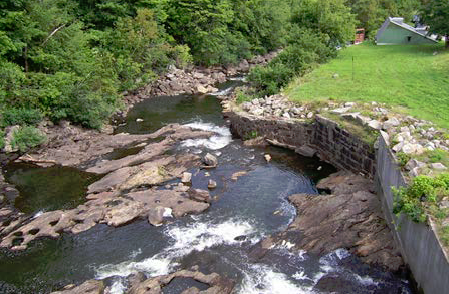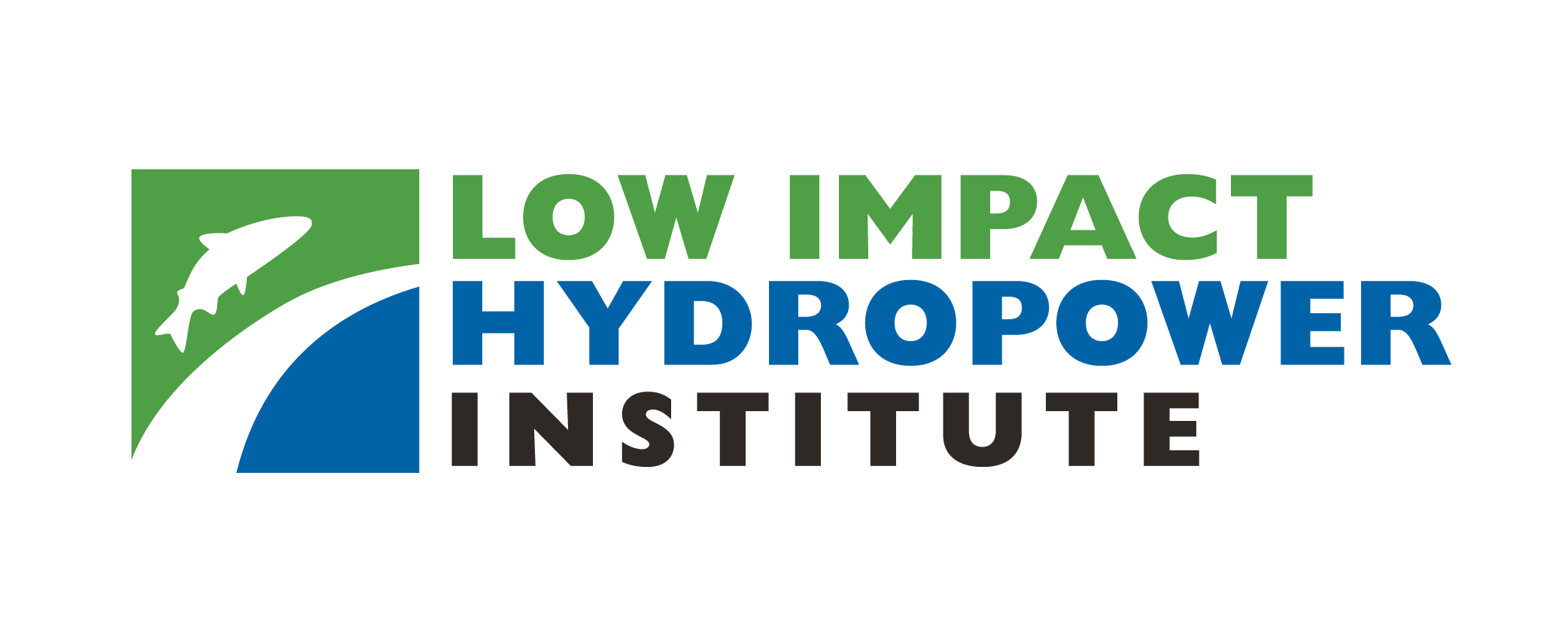LIHI 证书 #191 - 美国缅因州纸巾项目

| 项目名称 | 美国纸巾 |
| LIHI 证书编号 | 191 |
| LIHI 证书期限 | 2022年4月26日 – 2032年4月25日 |
| 所有者 | KEI(缅因州)电源管理(III)有限责任公司 |
| 状态 | 缅因州 |
| 地点 | Cobbosseecontee 河上的 1.2 英里河流 |
| 装机容量 | 1.0 兆瓦 |
| 平均年发电量 | 5,430 兆瓦时 |
| 设施类型 | 河流径流 |
| 联邦能源管理委员会 不。 | P-2809,2019 年颁发,2059 年 4 月 30 日到期 |
美国纸巾项目位于缅因州肯纳贝克县加德纳的科博西康蒂河上。在这条 11 英里长的河流上的五座水坝中,该项目是唯一一座 坝 用于水力发电。
该项目大坝于 1900 年建成,作为 径流 设施,直到 发电站 1970年被大火烧毁。该项目于1979年5月9日重新获得许可,并于1983年重建完成后开始运营。
该项目包括 重力坝 包括:
- 西侧有一座 61 英尺长、26 英尺高、7 英尺宽的 邻接 2英尺高 闪光板;
- 100 英尺长 泄洪道 高度从 19 英尺到 23 英尺不等,溢洪道顶部有 1 英尺高的挡水板,最高处海拔 123.3 英尺。泄洪道的泄洪能力为 8,700 立方英尺/秒,海拔 128.7 英尺/秒;
- 长 95 英尺、高 27 英尺、宽 10 英尺的东桥台;
其他项目内容包括:
- 三根直径 4.67 英尺的钢管 滑动 门 位于大坝底部
- 下游 鱼道 和 瀑布水潭;
- 上游 鳗梯;
- 一个带有 2 英寸净距拦污栅的进水口,将水排入 280 英尺长、7 英尺直径的地下钢管 压力水管 到发电站。从 6 月 1 日到 11 月 15 日,项目业主将安装完整的拦污栅覆盖层,以将净距减小到 7/8 英寸。
- 发电站内装有一台 1.0 兆瓦卡普兰涡轮机/发电机。涡轮机
可以在 100 CFS 至 360 CFS 的液压流量范围内运行; - 尾水渠;
- 一条 250 英尺长的 12 千伏 (kV) 输电线路,配有升压 变压器.
该项目采用径流模式运行,拦蓄 5.5 英亩的水库,形成 345 英尺长的旁路河段。12 月 1 日至 5 月 31 日期间,旁路最小流量为 10 立方英尺/秒,6 月 1 日至 11 月 30 日期间,旁路最小流量为 29 立方英尺/秒。释放最小流量后,如果剩余流入量低于 100 立方英尺/秒,则涡轮机不运行,剩余流入量将溢流出溢洪道。 流入 100 立方英尺/秒至 360 立方英尺/秒的水流通过涡轮机,同时保持蓄水池的正常水位。大于 360 立方英尺/秒的流入量通过溢洪道。该流动方式是与美国鱼类和野生动物管理局协商后制定的。
项目范围内的水域被指定为 B 类,支持指定用途,包括水生生物栖息地、处理后的饮用水供应、钓鱼、水上和水上娱乐以及水力发电。2015 年 6 月至 10 月对项目范围进行了水质测试。测试结果经缅因州环境保护部 (MDEP) 确认,溶解氧符合 B 类标准。然而,由于上游水源的营养负荷,未达到 B 类水生生物标准。根据 MDEP 的说法,该项目没有造成或促成营养富集。
Cobbosseecontee 溪流历史上曾支持过七种本地鸟类的迁徙 洄游性 鱼。从 Gardiner 纸板开始 坝,引入没有 鱼道 严重减少或 拔除 这些物种从水道中消失。鲱鱼、美洲西鲱、大西洋鲑、蓝背鲱鱼、虹鳟和条纹鲈鱼均被阻止向上游迁徙。该项目大坝建于 1879 年,比最低的大坝加德纳纸板坝 5 号的建造时间(1761 年)晚了 100 多年。鲱鱼被重新引入河中以吸引运动鱼类,这是缅因州海洋资源部 (MDMR) 采用的一种成功策略。项目所有者咨询了 MDEP、MDMR、缅因州内陆渔业和野生动物以及国家海洋渔业局,以设计和实施美洲鳗永久性上游通道设施。鳗鱼梯的运行时间为 6 月 1 日至 9 月 15 日,或根据现场条件由资源机构建议。下游 鱼道 设施的运行时间为 6 月 1 日至 11 月 30 日,或根据现场情况由资源机构建议运行。下游美洲鳗鱼通道的运行时间为 8 月 15 日至 11 月 15 日。
项目用地面积约为 7 英亩。Cobbosseecontee 流域的地形主要是起伏的低海拔丘陵和山谷。项目区主要为森林覆盖的高地,项目区沿岸分布着落叶林和混交林。
项目附近可能存在的受威胁或濒危物种包括北长耳蝙蝠、小棕蝠、东部小足蝙蝠、大棕蝠、红蝙蝠、灰毛蝙蝠、银毛蝙蝠和三色蝙蝠。项目区域不支持这些物种的关键栖息地。此外,由于占地面积小,该项目不太可能对列出的物种产生不利影响。
项目区域是加德纳磨坊遗址的所在地,这些遗址位于蓄水池下方,只有在定期排水时才会短暂露出水面。人们对这些遗址的完整性以及它们是否有资格列入世界遗产名录知之甚少。 国家历史遗迹名录. 在削减资金之前必须与州历史保护官员进行协商,以制定保护措施来帮助保护可能暴露的任何历史财产。
项目附近的休闲资源包括水库附近的城市公园。由于南岸林木茂密,地形陡峭,且有工业/商业用途,因此项目用地的出入通常受到限制。从水库到加德纳纸板坝下游的手提船码头有一条非正式的独木舟搬运路线。
合规状态
该证书包括以下针对设施的特定条件:
条件 1: 在向 LIHI 提交的年度合规性报告中,设施所有者应提供所有年度上游和下游鱼类通道报告和有效性监测结果的副本。还应提供任何机构对鱼类通道改进的意见和/或建议的摘要,以及实施此类变更的计划和时间表。
条件2: 应该上游 溯河洄游鱼类 如果在 LIHI 认证期限内需要通行,设施所有者应在机构咨询开始后 60 天内向 LIHI 发出通知,并应在向 LIHI 提交的年度合规文件中总结通行设施完成的进展情况。
条件3: 在向 LIHI 提交的年度合规文件中,设施所有者应表明是否发生了任何会触发 SHPO 咨询的蓄水池放水情况,并应确认已完成适当的咨询和侦察及资格调查。
2025: 未发现任何重大变更或合规问题。根据年度审查,该项目仍然合规。对于条件1,该项目报告仍在等待机构对2023年和2024年年度报告的评论。对于条件2和条件3,该项目报告未开展任何活动。
2024: 未发现任何重大变更或合规问题。根据年度审查,该项目仍然合规。对于条件1,该项目报告正在等待各机构对2023年报告草案的评论。对于条件2,该项目报告没有鱼类通行请求。对于条件3,该项目报告没有发生水位下降。
2023: 未发现任何重大变化或合规问题。根据年度审查,该项目仍然合规。对于条件 1,该项目报告年度报告草案正在接受机构审查。对于条件 2,该项目报告没有鱼类通行请求。对于条件 3,该项目报告没有发生任何下降。
2022: 当前证书的年度报告尚未生效。
认证历史
2022 年 8 月 9 日: 2022 年 8 月 4 日上诉期结束后,认证美国组织项目的决定成为最终决定,且未提出上诉。认证期限为 2022 年 4 月 26 日至 2032 年 4 月 25 日。
2022 年 7 月 5 日: 低影响水电研究所 (LIHI) 已初步批准美国 Tissue 水电项目的低影响认证(待定 LIHI #191)。完整申请和审核报告如下。此决定是初步决定,需等待 30 天的上诉期。只有在 60 天的评论期内对初始申请发表评论的人才有资格提出上诉。此类上诉需要包括对项目不符合 LIHI 标准的解释。上诉请求可以通过电子邮件提交至 comments@lowimpacthydro.org 主题行中请注明“美国组织项目”,或邮寄至 Low Impact Hydropower Institute,地址:1167 Massachusetts Ave, Office 407, Arlington, MA 02476。所有申请都将发布在网站上。申请人将有机会作出回应,任何回应也将发布。 申请必须在 2022 年 8 月 4 日下午 5 点(美国东部时间)之前收到。如果没有收到上诉请求,认证期限将为 2022 年 4 月 26 日至 2032 年 4 月 25 日。
2019年11月13日: 低影响水电研究所已收到美国 Tissue 水电项目低影响认证的完整申请。LIHI 正在就此申请征询公众意见。具体来说,我们想知道您是否认为该项目符合 LIHI 低影响认证标准(第二版手册中修订版)。该项目的申请材料如下。与特定 LIHI 标准(流量、水质、鱼类通道等)直接相关的意见将最有帮助,但所有意见都会被考虑。意见可以通过电子邮件提交给研究所,地址为 comments@lowimpacthydro.org 主题行为“美国组织项目评论”,或邮寄至低影响水电研究所,地址:329 Massachusetts Avenue, Suite 6, Lexington, MA 02420。 评论必须在 2020 年 1 月 12 日美国东部时间下午 5 点或之前收到 予以考虑。所有评论都将发布到网站上,申请人将有机会作出回应。任何回应也将发布。
认证文件
2022 年认证
- 2022 年美国组织审查报告
- 美国组织 LIHI 申请 2019
- 美国鱼类和野生动物管理局评论信 – American Tissue 2020
- NMFS 评论函 – 美国纸巾 2020
- ME 海洋资源评论信 – American Tissue 2020
- 缅因州河流评论信 – 美国卫生纸 2020
- 韦尔斯评论信 – 美国纸巾 2020
- MDEP 评论信 – 美国卫生纸 2020
- 上游评论信 – 美国纸巾 2020
